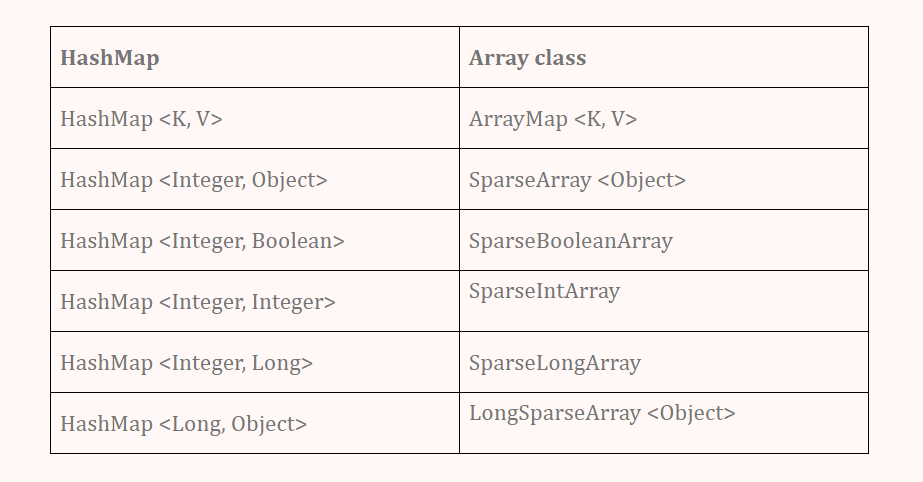日常开发中,常用的存储键值对的数据结构是HashMap,根据Java 笔记之 HashMap 保存数据和Java 笔记之计算 Java 对象的大小及其应用可以知道,HashMap存储键值对会占用比较多的内存控件,而对于内存限制较大的 Android 平台来说,为了避免这种浪费,官方推荐我们使用SpareArray和ArrayMap,本文对这两个类的实现进行分析比较。
SpareArray以及他的衍生类都是以基本类型为key,因为避免了自动装箱,并且用数组直接保存 key、value(而非像HashMap那样将其封装为Node对象后再保存),因而节省了内存。
ArrayMap则支持所有类型的 key,他是将key和value全部保存在一个数组中(n位为key,n+1位为value),避免了将其封装为Node对象带来的内存消耗。
当要保存的数据量比较小(小于几千个)的时候,如果 KEY 是基本类型,推荐使用SparseArray及其衍生类以节省内存,如果 KEY 是其他类型则使用ArrayMap;否则使用HashMap更加高效。
SpareArray
SpareArray以及他的衍生类主要用于以基本类型为key保存非大量数据的场景。
相比HashMap而言,他的优点主要在于没有对保存的数据二次封装,没有对基本类型的数据自动装箱,存储单个数据的成本小,也没有hash计算。
但他在添加数据时需要扩展数组 (涉及到新建、复制数组,gc()等),在删除数据时需要缩减数组 (查看gc()等源码发现他的数组只会增加,不会缩减),以及通过二分法查找索引都会消耗性能。
为了避免每次删除时都需要缩减数组,
SpareArray在删除数组时只会将其赋值为DELETED,在下次调用其private void gc()方法时丢弃掉这些数据
先看一下SpareArray的结构:
public class SparseArray<E> implements Cloneable {
private boolean mGarbage = false; //是否调用 gc() 方法
private int[] mKeys;//所有的 key
private Object[] mValues;//所有的 value
private int mSize;//所保存的数据个数
}
void put(int key, E value)
添加方法先用二分法查找key对应的位置:
- 如果有,则直接覆盖
- 如果没有,则取反得到应该
插入的位置,并分别插入key和value
public void put(int key, E value) {
// 先用二分法查找 key 对应的索引,找到的话返回对应索引,
// 否则返回 key 应该插入的位置的取反值
int i = ContainerHelpers.binarySearch(mKeys, mSize, key);
if (i >= 0) {
// 如果已存在值则直接覆盖
mValues[i] = value;
} else {
// 对二分法查找到的值再取反,得到 key 应该插入的位置
i = ~i;
if (i < mSize && mValues[i] == DELETED) {
mKeys[i] = key;
mValues[i] = value;
return;
}
if (mGarbage && mSize >= mKeys.length) {
gc();
// Search again because indices may have changed.
i = ~ContainerHelpers.binarySearch(mKeys, mSize, key);
}
// public static <T> T[] insert(T[] array, int currentSize, int index, T element)
// Inserts an element into the array at the specified index,
// growing the array if there is no more room.
mKeys = GrowingArrayUtils.insert(mKeys, mSize, i, key);
mValues = GrowingArrayUtils.insert(mValues, mSize, i, value);
mSize++;
}
}
E get(int key)
获取数据,先用二分法查找,如果找到就返回对应的值,否则返回null。
public E get(int key) {
return get(key, null);
}
public E get(int key, E valueIfKeyNotFound) {
int i = ContainerHelpers.binarySearch(mKeys, mSize, key);
if (i < 0 || mValues[i] == DELETED) {
return valueIfKeyNotFound;
} else {
return (E) mValues[i];
}
}
void remove(int key)
删除key以及对应的数据。
同样先用二分法查找对应位置,有的话则标记为DELETED,等待下次gc()时丢弃。
public void remove(int key) {
delete(key);
}
public void delete(int key) {
int i = ContainerHelpers.binarySearch(mKeys, mSize, key);
if (i >= 0) {
if (mValues[i] != DELETED) {
mValues[i] = DELETED;
mGarbage = true;
}
}
}
gc()
在上文中我们看到,删除数据时,mGarbage被标记为true,这样当下一次进行put/valueAt/append/size等涉及到数组大小查询、改动等时,就出触发gc()以便整理数组结构。
private void gc() {
// Log.e("SparseArray", "gc start with " + mSize);
int n = mSize;
int o = 0;
int[] keys = mKeys;
Object[] values = mValues;
for (int i = 0; i < n; i++) {
Object val = values[i];
// 这里的操作只是将没有被删除的数据移动到了数组的前面
// 而保证了数组后面都是 DELETED 或 null,方便后续操作
if (val != DELETED) {
if (i != o) {
keys[o] = keys[i];
values[o] = val;
values[i] = null;
}
o++;
}
}
mGarbage = false;
mSize = o;
}
HashMap 与 SpareArray 及其衍生类对应关系
参考下图

ArrayMap
ArrayMap实现了Map<K, V>接口,他的 API 和HashMap相差无几,但是由于没有对数据再包装,动态调整数组的大小,一定范围内他比HashMap内存效率高。
但是如果保存大量数据(超过千位)时,由于他需要二分法查找的影响会比HashMap慢很多。
ArrayMap特殊之处在于将key,value保存到了同一个数组 mArray 中(n 位保存 key,n+1 位保存 value)。
先看一下ArrayMap的结构:
static Object[] mBaseCache;
static int mBaseCacheSize;
static Object[] mTwiceBaseCache;
static int mTwiceBaseCacheSize;
final boolean mIdentityHashCode;//是否强制使用 System.identityHashCode(key) 获取 key 的 HashCode
//System.identityHashCode(key) 方法无论类是否重写了 hashCode() 方法,
//都会调用 Object.identityHashCode(key) 来获取对象的 hashCode
int[] mHashes;//存储所有 key 的 hash 值
Object[] mArray;//存储 key 和 value,大小是 mHashes 的两倍
//n 位保存 key,n+1 位保存 value
int mSize;
MapCollections<K, V> mCollections;
在使用时:
计算
key的hash值,hash = mIdentityHashCode ? System.identityHashCode(key) : key.hashCode();然后使用
indexOf()在mHashes中进行二分法查找对应的indexindex = indexOf(key, hash);indexOf()方法会先用二分法查找hash对应的index,如果index<0则返回index;否则在对比mArray中对应位置mArray[index<<1]的key与要查询的key:- 两者一致:返回
index - 两者不一致:从
index开始,先向后,再向前查询是否有相同的key,如果有返回对应index - 以上都没有找到:对
mHashes中最后一个与key的hash一致的后一位index取反,并返回
int indexOf(Object key, int hash) { final int N = mSize; // Important fast case: if nothing is in here, nothing to look for. if (N == 0) { return ~0; } int index = binarySearchHashes(mHashes, N, hash); // If the hash code wasn't found, then we have no entry for this key. if (index < 0) { return index; } // If the key at the returned index matches, that's what we want. if (key.equals(mArray[index<<1])) { return index; } // Search for a matching key after the index. int end; for (end = index + 1; end < N && mHashes[end] == hash; end++) { if (key.equals(mArray[end << 1])) return end; } // Search for a matching key before the index. for (int i = index - 1; i >= 0 && mHashes[i] == hash; i--) { if (key.equals(mArray[i << 1])) return i; } // Key not found -- return negative value indicating where a // new entry for this key should go. We use the end of the // hash chain to reduce the number of array entries that will // need to be copied when inserting. return ~end; }- 两者一致:返回
V put(K key, V value)
当添加item时,按照前述规则,先在mArray中查找key对应的索引index:
index >= 0:已经有键为key的数据,直接覆盖旧值并返回index < 0:没有键为key的数据,对数组进行扩容,并保存对应数据index = ~index;//上文 indexOf() 中计算得出的 key 应该添加的位置 mHashes[index] = hash; mArray[index<<1] = key; mArray[(index<<1)+1] = value;
V get(Object key)
get()方法就比较简单了,先查找key的索引,然后取出对应的数据value并返回即可:
public V get(Object key) {
final int index = indexOfKey(key);
return index >= 0 ? (V)mArray[(index<<1)+1] : null;
}
V remove(Object key)
remove()方法也会先使用indexOfKey()计算key的index,然后删除对应位置的数据。
此外,如果mHashes.length > (BASE_SIZE*2) && mSize < mHashes.length/3的话,还会缩减数组的大小为osize > (BASE_SIZE*2) ? (osize + (osize>>1)) : (BASE_SIZE*2):
public V removeAt(int index) {
//...其他代码
if(mHashes.length > (BASE_SIZE*2) && mSize < mHashes.length/3){
//...其他代码
final int n = osize > (BASE_SIZE*2) ? (osize + (osize>>1)) : (BASE_SIZE*2);
allocArrays(n);
}
//...其他代码
}
private void allocArrays(final int size) {
//...其他代码
mHashes = new int[size];
mArray = new Object[size<<1];
}
有想法?欢迎通过邮件讨论。